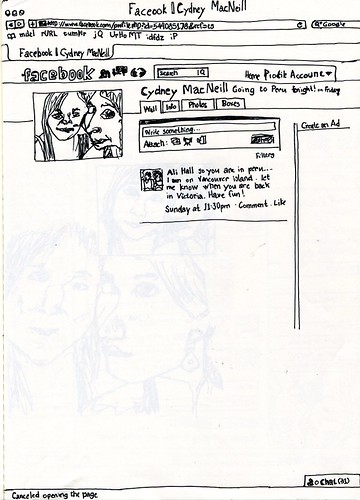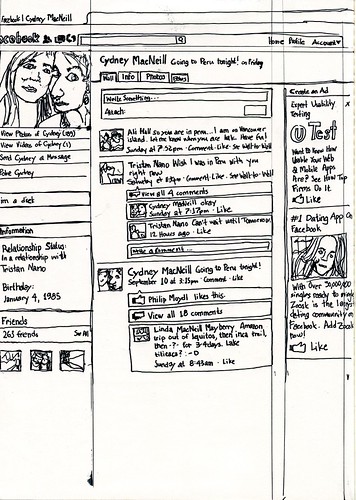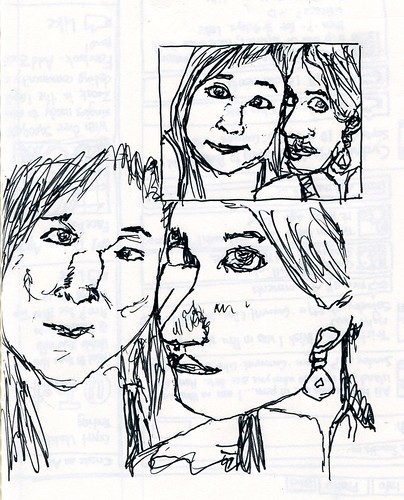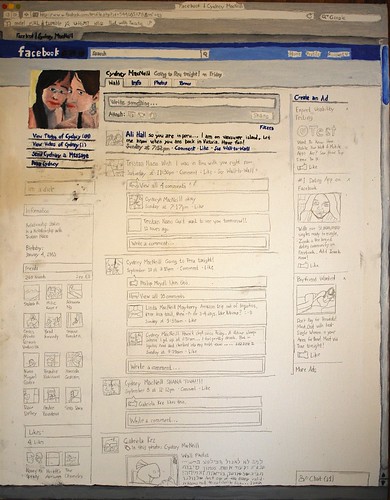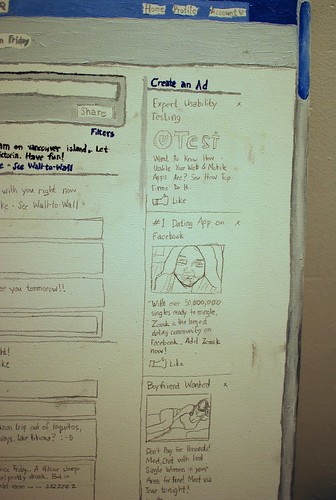About eight years ago, I had the idea of making oil paintings of web sites. Since most of the people I know spend huge portions of their day staring at web sites, the web constitutes a truly enormous portion of contemporary visual culture. As such, it makes more than a little bit of sense as a subject for painting, which has at least since Beaudelaire, (intermittently) taken as its aim, the capturing of contemporary life.
I never actually set about the project because I assumed that this ubiquity meant that someone must already be making work like this. Every time I walked into a gallery, I braced myself to finally see paintings of websites; but the moment never came.
Hence, I’ve decided to finally actually make some paintings on this premise. To be specific, I’ve decided to make a series of portraits of people in the form of paintings of their Facebook pages. I’m going to focus on people with whom my relationship is largely (or even exclusively) mediated by Facebook.
For my first subject, I chose my friend Cydney, MacNeill. Cydney is a helicopter pilot in Vancouver, BC. I met her last summer when we were seated next to each other on a flight from Vancouver to Toronto. We spent the six or so hours of that flight chatting and have never met in person since. We occasionally chat via Facebook and I follow her updates with interest.
I started work on the piece by taking a screen shot of Cydney’s profile page. Since the information in any Facebook profile changes so rapidly (in fact, Cydney has already changed her profile picture since I began working on the pice), in order to treat it as a depictable visual object, I had to freeze it in time at a given point.

Having done this, I proceeded to make a series of pen and ink sketches based on this image. At first I was greatly struggling with the proportions of the page layout. Conceptually, a Facebook page is taller than it is wide and, hence, a good match for the vertically proportioned canvas that’s traditional for portraiture. However, in practice, since our monitors are horizontal, we only see a horizontal section of the full vertical page at any one time. This made it difficult for me to get the proportions correct and caused my first few sketches to be distorted
Finally, I made some basic proportional measurements using the traditional pencil-held-up-to-eye scaling technique and was able to make a basic sketch of the top part of the page that was relatively proportional.
That done, I set about practicing my drawing of Cydney’s actual profile picture. Even though the conceptual premise of the piece is that the whole page constitutes a portrait of her, the profile photo plays an important role as it is both the main visual representation of Cydney on the page and the element that is most self-consciously a self-portrait.
Having done this work of sketching, I set about transferring the sketch to canvas. One conscious choice I made at this point which I’d planned all along but is not fully clear in the sketches was to include the browser “chrome”: the address and bookmark bars, the scroll bar, etc. These elements constitute the frame through which I (and any other web user) views a page. I thought that having them present in this supposed portrait of Cydney would implicate my point of view in a way that is a convention of traditional portraiture, but also inseparable from the web browsing experience.
I have yet to complete the full painting, but having spent about 20 hours in the process staring at and thinking about this single Facebook page, I’ve learned some things I can discuss: ideas that I think are inherent and that I’d like to bring out in this series of work as it progresses.
The first point I can make continues this theme, arising from the browser chrome, of my point of view. Facebook itself inserts me into this page in two main ways: it offers me the chance to “Write something” about Cydney, either as comments on her status updates or, prominently, on her wall directly. Further, the top strip of UI on the page is addressed directly to me as an aid to navigation of the site: it offers me the chance to move away from Cydney’s page (an option which is, of course, not actually available to the viewer of the painting, but more about that paradox in a moment). Finally, and maybe most interesting, The column of ads along the right side of the page expresses a series of assumptions Facebook seems to have about me as a user of its site and as a view of Cydney’s page in particular. Two of the three ads are for dating services and feature pictures of attractive women. The juxtaposition of these ads with the overall context of my gaze at Cydney’s page seems to make certain assertions about my desire or emotional state in relationship to Cydney: i.e. that I’m viewing this page out of a sense of romantic desire. Having Facebook’s interface (it’s “gaze” on me from the cloud of data it has about me) projected into this portrait complicates my intention that it should be “of Cydney” and exaggerates the art historical convention I mentioned above of implicating the portraitist in a portrait, but, in this case, in a way that is interestingly out of my control.
A second, minor point, hinted at in my discussion of the comment boxes, is the viewer’s relationship to the interactive interface elements on the page. The links and text fields on this page present themselves as invitations to action — “View Photos of Cydney”, “Write something”, “Poke Cydeny” — however, these invitations are addressed to me as the user of the page and are not actually accessible to the viewer of the painting.
However, one gap in that inaccessibility is the URL bar in the browser chrome at the top of the painting.
As you can see here, close inspection of that browser bar would allow a user to actually transcribe the URL for Cydney’s page and, if he wanted, visit it himself. Facebook’s privacy controls may or may not allow the viewer to see this page the way I do, but he could at least verify that it exists and, possibly, actually reach out and send Cydney a message, not something usually enabled by conventional portraits.
Another interesting point stems from what, in practice, ends up making up the majority of the time that goes into making a painting of a Facebook page: representing text. As I attempted to “draw” the digital typography on the page (paying close attention to the letterforms as visual objects), it would always partially collapse back into handwriting, as I was literally writing with my hand and a brush.
Further, while I did my best to re-create the position of the text exactly, hand writing it causes it to spread out and occupy the layout slightly differently. This required me to use my knowledge of the rules of HTML and CSS to act in the browser’s stead as a layout engine: to place the text where the browser would have if it had been that size when it was rendering the page.
There’s a lot more I could say about what it means to make a painting of a Facebook page, but as this is a work in progress, I’ll end by talking about some of the concerns that occupy me as I proceed. I have intentionally not sought a “photorealistic” look in this painting since such techniques typically involve machine transfer of the image and the whole point here is to mediate it through my hand in order to depict the website itself as a visual object. However, the kinds of visual elements that make up a website: straight lines, complexly rendered UI elements, photographs, tend to exaggerate the hand-made quality of the image, potentially making the irony of the approach too obvious or cloying.
Another potential trap as I make more of these paintings will be the repeated sameness of the browser chrome and the unchanging parts of the Facebook UI will make it tempting to render those by rote rather than giving them the close examination that is the purpose of the whole exercise. This is a problem I’ve already begun to encounter as I go through the very labor intensive process of painting all the fiddly and repeating bits of the Facebook UI.
One final problem I feel like I’ve already fallen into comes from the presence of the photographic elements on the page. Since these are so much richer as subjects for painting than the textual and UI elements (more colorful, containing actual modeling, etc.), I find myself spending an inordinate amount of time on them compared to the textual and design elements. I’ve tried to limit this by leaving the portrait image relatively rough, but it’s still very difficult not to enact a hierarchy of representation on page the deemphasizes the interface and information elements in favor of these lusciously visual ones, but I think that would be a failure to take the page itself as the object of the painting, which is the intention of the project.

